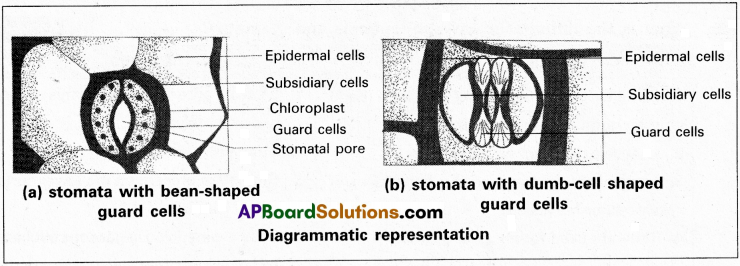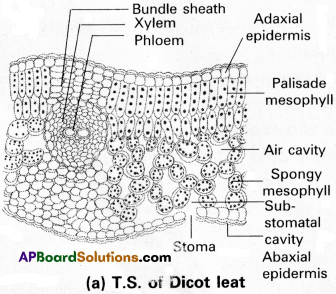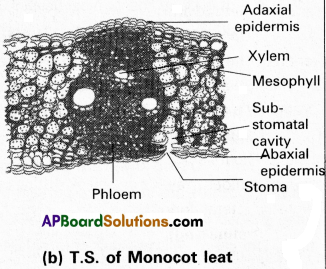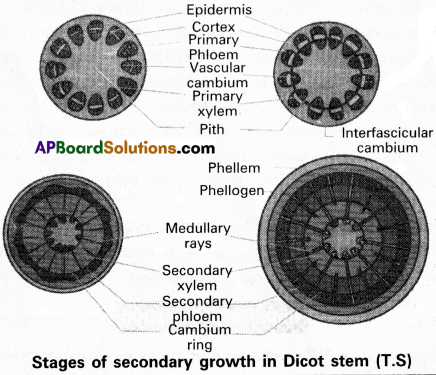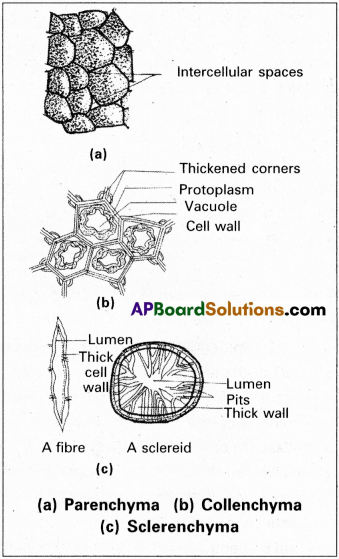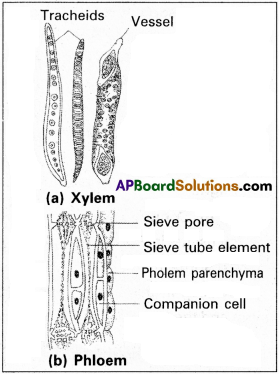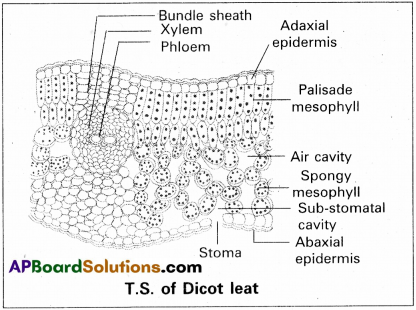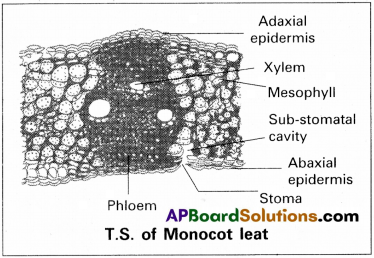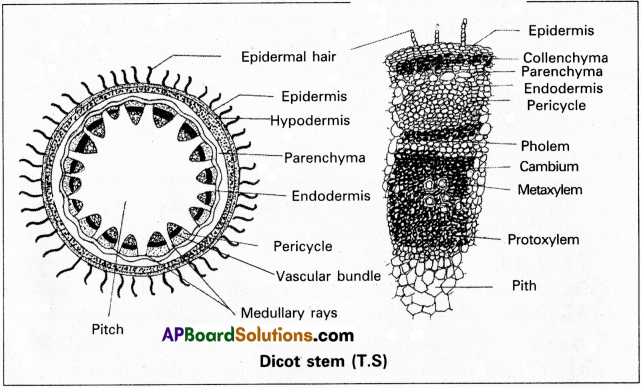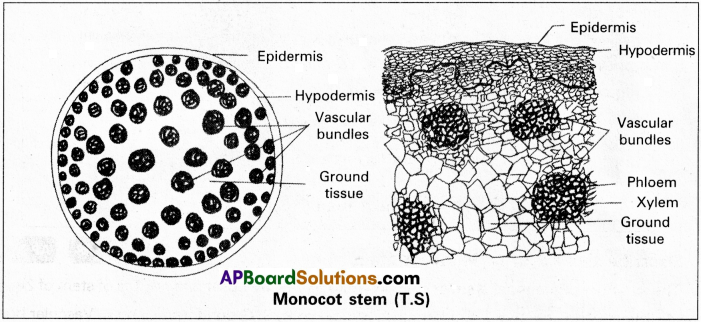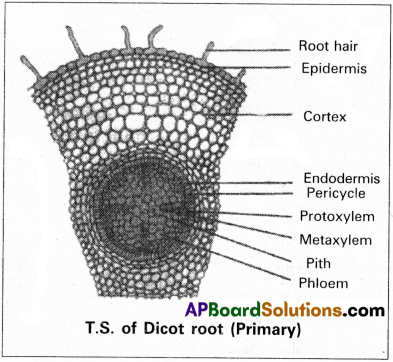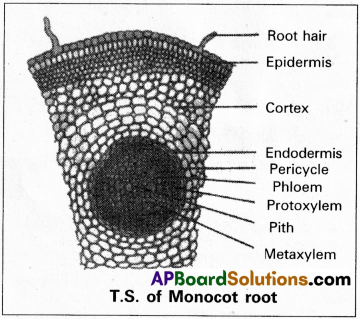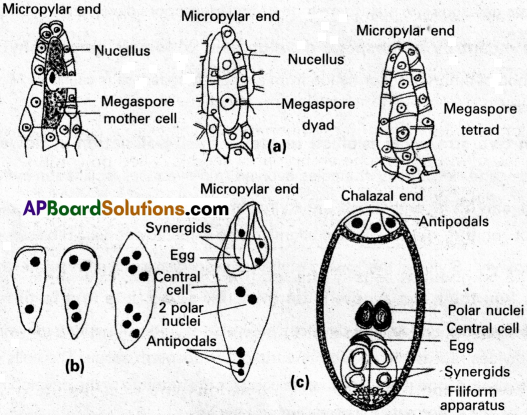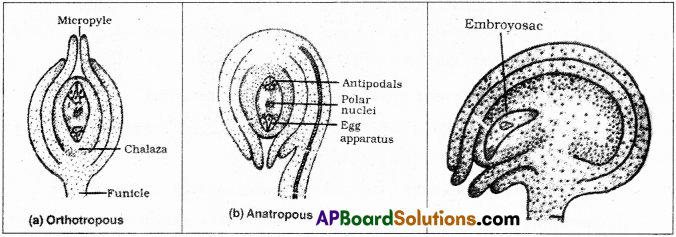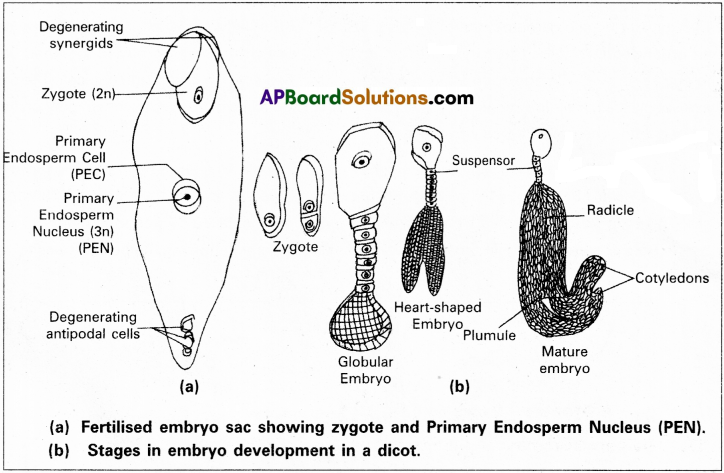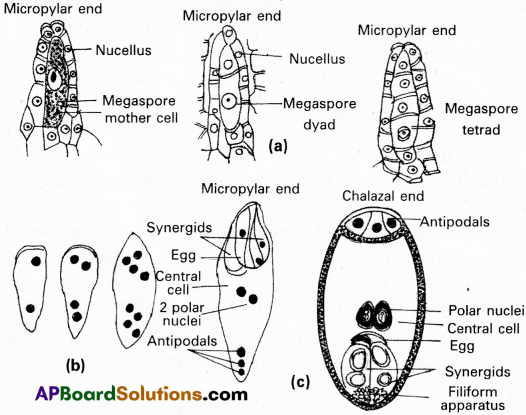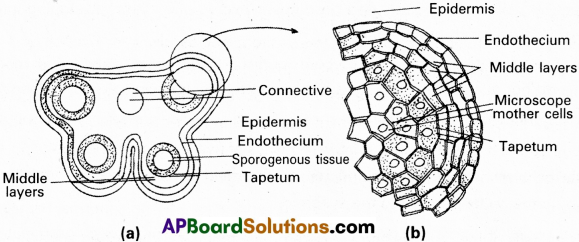Andhra Pradesh BIEAP AP Inter 1st Year Physics Study Material 4th Lesson Motion in a Plane Textbook Questions and Answers.
AP Inter 1st Year Physics Study Material 4th Lesson Motion in a Plane
Very Short Answer Questions
Question 1.
The vertical component of a vector is equal to its horizontal component. What is the angle made by the vector with x-axis?
Answer:
The horizontal component is equal to the vertical component of a vector.
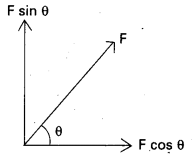
F cos θ = F sin θ.
Tan θ = 1 .
θ = tan-1(1) = 45°.
Question 2.
A vector V makes an angle 0 with the horizontal. The vector is rotated through an angle 0. Does this rotation change the vector V ?
Answer:
Yes, it changes the vector.
![]()
Question 3.
Two forces of magnitudes 3 units and 5 units act at 60° with each other. What is the magnitude of their resultant ? [A.P. Mar. 15]
Answer:
Let P = 3 units, Q = 5 units, θ = 60°
Resultant (R) = \(\sqrt{p^2+Q^2+2 P Q \cos \theta}\)
= \(\sqrt{3^2+5^2+2 \times 3 \times 5 \times \cos 60^{\circ}}\)
= \(\sqrt{9+25+30 \times \frac{1}{2}}=\sqrt{49}\) = 7 units
Question 4.
A = \(\vec{i}+\vec{j}\). What is the angle between the vector and X-axis ? [T.S., A.P. Mar. 17; Mar. 14, 13]
Answer:
A = \(\vec{i}+\vec{j}\)
cos α = \(\frac{A x}{|A|}\) (∵ Ax = 1)
= \(\frac{1}{\sqrt{1^2+1^2}}=\frac{1}{\sqrt{2}}\)
α = cos-1 \(\left(\frac{1}{\sqrt{2}}\right)\) = 45°
Question 5.
When two right angled vectors of magnitude 7 units and 24 units combine, what is the magnitude of their resultant ? [A.P. Mar. 16]
Answer:
θ = 90°, P = 7 units, Q = 24 units
R = \(\sqrt{P^2+Q^2+2 P Q \cos \theta}\)
R = \(\sqrt{7^2+24^2+2 \times 7 \times 24 \times \cos 90^{\circ}}=\sqrt{49+576}=\sqrt{625}\) = 25 units.
Question 6.
If p = 2i + 4j + 14k and Q = 4i + 4j + 10k find the magnitude of P + Q. [T.S. – Mar. ‘16, ‘15]
Answer:
P = 2i + 4j + 14k, Q = 4i + 4j + 10k,
\(\overrightarrow{\mathrm{P}}+\overrightarrow{\mathrm{Q}}\) = 2i + 4j + 14k + 4i + 4j + 10k
= 6i + 8j + 24k
|\(\overrightarrow{\mathrm{P}}+\overrightarrow{\mathrm{Q}}\)| = \(\sqrt{6^2+8^2+24^2}=\sqrt{676}\)
![]()
Question 7.
Can a vector of magnitude zero have non-zero components?
Answer:
No, the components of a vector of magnitude zero have non-zero components..
Question 8.
What is the acceleration projectile at the top of its trajectory?
Answer:
The acceleration of a projectile at the top of its trajectory is vertically downwards.
Question 9.
Can two vectors of unequal magnitude add up to give the zero vector? Can three unequal vectors add up to give the zero vector?
Answer:
No, two vectors of unequal magnitude cannot be equal to zero. According to triangle law, three unequal vectors in equilibrium can be zero.
Short Answer Questions
Question 1.
State parallelogram law of vectors. Derive an expression for the magnitude and direction of the resultant vector. [T.S. – Mar. 16; Mar. 14, 15]
Answer:
Statement: If two vectors acting d a point are represented by the adjacent sides of a parallelogram in magnitude and direction, then their resultant is represented by the diagonal of the parallelogram in magnitude and direction dawn from the same vector.
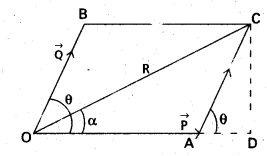
Explanation L Let two forces \(\overrightarrow{\mathrm{P}}\) and \(\overrightarrow{\mathrm{Q}}\) point O. Let θ be the angle between two nrces. Let the side O = \(\overrightarrow{\mathrm{P}}\) and OB = \(\overrightarrow{\mathrm{Q}}\). The parallelogram OACB is completed. The points O and C are joined. Now OC = \(\overrightarrow{\mathrm{R}}\)
![]()
Resultant magnitude :
In fig \(\overrightarrow{O A}=\vec{p}, \overrightarrow{O B}=\vec{Q}, \overrightarrow{O C}=\vec{R}\)
In the triangle COD. OC2 = OD2 + CD2
0C2 = (OA + AD)2 + CD2 (: OD = OA + AÐ)
OC2 = OA2 + AD2 + 2OA. AD + CD622
OC2 = OA2 + AC2 + 2OA. AD …………… (1)
From ∆le CAD, AD2 + CD2 = AC2
From ∆le CAD, cos θ = \(\frac{A D}{A C}\)
AD = AC cos θ ……………. (2)
∴ R2 = P2 + Q2 + 2 PQ cosθ
R = \(\sqrt{\mathrm{P}^2+\mathrm{Q}^2+2 \mathrm{PQ} \cos \theta}\) ………….. (3)
Resultant direction:
Let (L be the angle made by the resultant vector \(\overrightarrow{\mathrm{R}}\) with \(\overrightarrow{\mathrm{P}}\)
Then tan α = \(\frac{C D}{O D}\)
tan α = \(\frac{C D}{O A+A D}\) ……………… (4)
In the triangle CAD, sinO = \(\frac{C D}{A C}\)
CD = AC sin θ
CD = Q sin θ ……………… (5)
∴ tan α = \(\frac{\mathrm{Q} \sin \theta}{\mathrm{P}+\mathrm{Q} \cos \theta}\) (∵ AD = Q COS θ)
α = tan-1 \(\left(\frac{Q \sin \theta}{P+Q \cos \theta}\right)\) ……………….. (6)
Question 2.
What is relative motion ? Explain It.
Answer:
Relative velocity is defined as the velocity of one body with respect to another body.
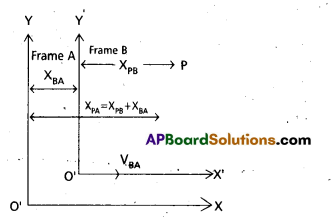
Let us consider two observers A and B are making measurements of an event P in space from two frames of reference as shown in figure. At the beginning let the two origins of the two reference frames coincide and are on the same line.
Let the observer B is moving with a constant velocity VBA with respect to A. Now we can connect the positions of the event P as measured by A with the position of P as measured by B.
As B is moving with constant velocity at the time of observation of event P, the frame B has moved a distance XBA with respect to A.
XPA = XPB + XBA …………….. (1)
“The position of P as measured by observer A is equal to the position of P as measured by B plus the position of B as measured by A”.
eq (1) can also be written as VPA = VPB + VBA …………….. (2)
Question 3.
Show that a boat must move at an angle with respect to river water in order to cross the river in minimum time.
Answer:
If the boat has to move along the line AB, the resultant velocity of VBE should be directed along AB and the boat reaches the point B directly. For this to happen, the boat velocity with respect to water VBW should be directed such that it makes an angle a with the line AB upstream as shown in the figure.
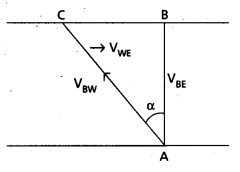
\(\frac{V_{W E}}{V_{B W}}\) = sin α ⇒ α = sin-1 \(\left(\frac{V_{\mathrm{WE}}}{\mathrm{V}_{\mathrm{BW}}}\right)\)
and VBE = \(\sqrt{V_{B W}^2-V_{W E}^2}\)
The minimum time taken by the boat to cross the river
t = \(\frac{A B}{V_{B E}}\)
t = \(\frac{A B}{\sqrt{V_{B W}^2-V_{W E}^2}}\)
Question 4.
Define unit vector, null vector and position vector.
Answer:
Unit Vector : A vector having unit magnitude is called unit vector.
\(\hat{A}=\frac{A}{|A|}\) where \(\hat{A}\) is unit vector.
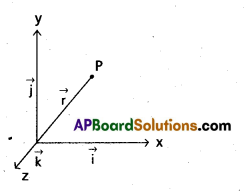
Null vector : A vector having zero magnitude is called null vector.
Position vector : The position of a particle is described by a position vector which is drawn from the origin of a reference frame. The position vector helps to locate the particle in space.
The position of a particle P is represented by
\(\overrightarrow{O P}=\vec{r}=x \vec{i}+y \vec{j}+z \vec{k}\)
![]()
Question 5.
If \(|\vec{a}+\vec{b}|=|\vec{a}-\vec{b}|\) prove that the angle between \(\vec{a}\) and \(\vec{b}\) is 90°.
Answer:
\(|\vec{a}+\vec{b}|=|\vec{a}-\vec{b}|\)
\(\sqrt{a^2+b^2+2 a b \cos \theta}=\sqrt{a^2+b^2-2 a b \cos \theta}\)
2 ab cos θ = – 2ab cos θ
4 ab cos θ = 0
cos θ = 0 but 4ab ≠ 0
∴ θ = 90°
Hence angle between \(\vec{a}\) and \(\vec{b}\) is 90°.
Question 6.
Show that the trajectory of an object thrown at certain angle with the horizontal is a parabola. [A.P. Mar. 18, 16, 15; T.S. Mar. 18, 15]
Answer:
Consider a body is projected with an initial velocity (u) making an angle 0 with the horizontal. The body does not experience acceleration in horizontal direction. The velocity of the projectile can be resolved in to (i) u cos θ, horizontal component (ii) u sin θ, vertical component. The horizontal component of velocity remains constant through out the motion. Only its vertical component changes due to acceleration due to gravity (g).
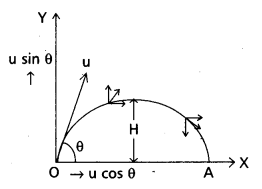
The distance travelled along OX in time t is given by
x = u cos θ × t
t = \(\frac{x}{u \cos \theta}\) ………………. (1)
The distance travelled along oy in time t is given by

Y = Ax – Bx2 Where A and B are constants.
This is the equation of parabola.
∴ The trajectory of a projectile is parabola.
Question 7.
Explain the terms the average velocity and instantaneous velocity. When are they equal ?
Answer:
Average velocity :
The average velocity of the particle is defined as the ratio of displacement (∆x) to the time interval ∆t
\(\bar{v}=\frac{\Delta x}{\Delta t}=\frac{x_2-x_1}{t_2-t_1}\)
Average velocity is independent of the path followed by the particle between the initial and final positions. It gives the result of the motion.
Instantaneous velocity:
The velocity of a particle at a particular instant of time is known as instantaneous velocity.

The instantaneous velocity may be positive (or) negative in straight line motion.
In uniform motion the instantaneous velocity of a body is equal to the average velocity.
![]()
Question 8.
Show that the maximum height and range of a projectile are \(\frac{U^2 \sin ^2 \theta}{2 g}\) and \(\frac{U^2 \sin 2 \theta}{g}\) respectively where the terms have their regular meanings. [Mar. 14]
Answer:
Maximum height:
When the projectile is at the maximum height, its vertical component of velocity vy = 0
Initial velocity (u) = u sin θ
Distance (s) = H = maximum height
Acceleration (a) = – g
using v2 – u2 = 2as,
0 – u2 sin2 θ = – 2gH
∴ H = \(\frac{u^2 \sin ^2 \theta}{2 g}\)
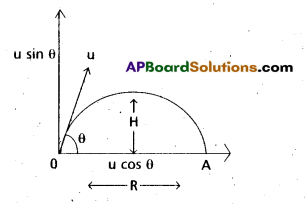
Horizontal range (R) .
The horizontal distance travelled by the projectile from the point of projection during the time of flight is called range. . .
Range (R) = Horizontal velocity × Time of flight
R = u cos θ × T = u cos θ × \(\frac{2 u \sin \theta}{g}\)
R = \(\frac{u^2 \times 2 \sin \theta \cos \theta}{\mathrm{g}}\)
R = \(\frac{u^2 \sin 2 \theta}{g}\)
If θ = 45°, RMax = \(\frac{u^2}{g}\)
Question 9.
If the trajectory of a body is parabolic in one reference frame, can it be parabolic in another reference frame that moves at constant velocity with respect to the first reference frame ? If the trajectory can be other than parabolic, what else can it be ?
Answer:
No, when a stone is thrown from a moving bus, the trajectory of the stone is parabolic in one reference frame. That is when a man observes out side foot path.
In another frame of reference, the trajectory is a vertical straight line.
![]()
Question 10.
A force 2i + j – k newton d’ts on a body which is initially at rest. At the end of 20 seconds the velocity of the body is 4i + 2j – 2k ms-1. What is the mass of the body ?
Answer:
F = (2i + j – k) N
t = 20 sec, u = 0
v = (4i + 2j – 2k) m/s
a = \(\frac{v-u}{t}=\frac{(4 i+2 j-2 k)-0}{20}\)
a = \(\frac{2 i+j-k}{10}\) m/s2
F = ma
mass (m) = \(\frac{\mathrm{F}}{\mathrm{a}}\)
= \(\frac{2 i+j-k}{\left(\frac{2 i+k}{10}\right)}\)
m = 10 kg
Problems
Question 1.
Ship A is 10 km due west of ship B. Ship A is heading directly north at a speed of 30 km/h. while ship B is heading in a direction 60° west of north at a speed of 20 km/h.
i) Determine the magnitude of the velocity of ship B relative to ship A.
ii) What will be their distance of closest approach ?
Answer:
i) VA = 30 kmph, VB = 20 kmp, θ = 60°
Relative velocity of ship B w.r.to ship A is
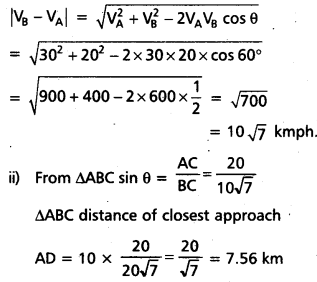
Question 2.
If θ is the angle of projection, R the range, h the maximum height of the floor. Then show that (a) tan θ = 4h/R and (b) h = gT2/8
Answer:
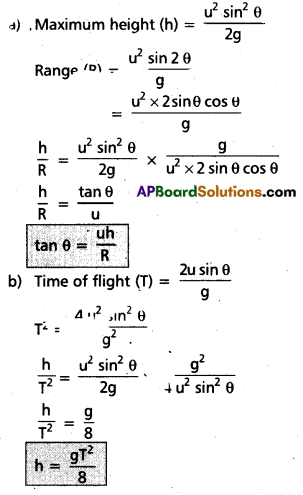
![]()
Question 3.
A projectile is fired at an angle of 60° to the horizontal with an initial velocity of 800 m/s:
i) Find the time of flight of the projectile before it hits the ground.
ii) Find the distance it travels before it hits the ground (range)
iii) Find the time of flight for the projectile to reach its maximum height.
Answer:
θ = 60°, u = 800 m/s
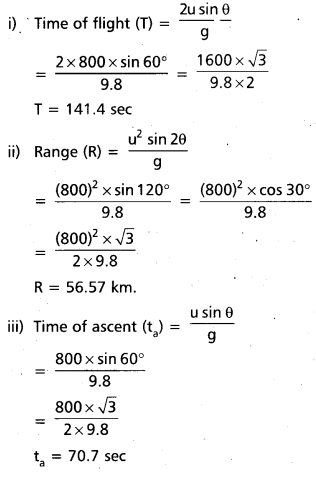
Question 4.
For a particle projected slantwise from the ground, the magnitude of its position vector with respect to the point of projection, when it is at the highest point of the path is found to be \(\sqrt{2}\) times the maximum height reached by it. Show that the angle of projection is tan-1 (2)
Answer:
Range (R) = \(\frac{u^2 \times 2 \sin \theta \cos \theta}{\mathrm{g}}\)
= \(\frac{\mathrm{u}^2 \sin 2 \theta}{\mathrm{g}}\) ………… (1)
Maximum height (h) = \(\frac{u^2 \sin ^2 \theta}{2 g}\) ……………….. (2)
Given R = \(\sqrt{2}\) h
\(\frac{u^2 \times 2 \sin \theta \cos \theta}{g}=\sqrt{2} \times \frac{u^2 \sin ^2 \theta}{2 g}\)
tan θ = 2 \(\sqrt{2}\)
θ = tan-1 (2\(\sqrt{2}\))
![]()
Question 5.
An object is launched from a cliff 20m above the ground at an angle of 30° above the horizontal with an initial speed of 30 m/s. How far horizontally does the object travel before landing on the ground ? (g = 10 m/s2)
Answer:
h = 20m, θ = 30°, u = 30m/s,
g = 10m/s2
h = -(u sin θ) t + \(\frac{1}{2}\) gt2
20 = – 30 sin 30° × t + \(\frac{1}{2}\) × 10 × t2
20 = – 30 × \(\frac{1}{2}\) × t + \(\frac{1}{2}\) × 10 × t2
4 = – 3t + t2
t2 – 3t – 4 = 0
(t – 4) (t + 1) = 0
t = 4 sec (or) t = -1 sec
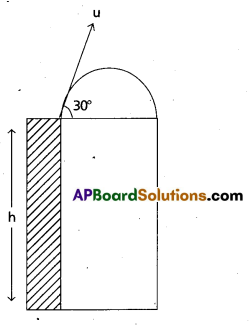
∴ Range (R) = u cos θ × t
= 30 cos 30° × 4
= 30 × \(\frac{\sqrt{3}}{2}\) × 4
R = 60\(\sqrt{3}\) m
Question 6.
O is a point on the ground chosen as origin. A body first suffers a displacement of 10 \(\sqrt{2}\) m North-East, next 10 m North and finally North-West. How far it is from the origin ?
Answer:
Given OB = 10 \(\sqrt{2}\) m, BC = 10m.
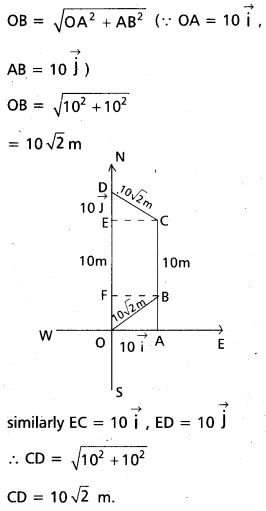
∴ Total displacement (OD) = | OF | + |FE| + || ED ||
OD = 10 + 10 + 10
OD = 30m
![]()
Question 7.
From a point on the ground a particle is projected with initial velocity u, such that its horizontal range is maximum. Find the magnitude of average velocity during its ascent.
Answer:
S = \(\sqrt{\left(\frac{R}{2}\right)^2+\left(\frac{R}{4}\right)^2}=\sqrt{\frac{R^2}{4}+\frac{R^2}{16}}\)
= \(\sqrt{\frac{4 R^2+R^2}{16}}=\frac{\sqrt{5} R}{4}\)
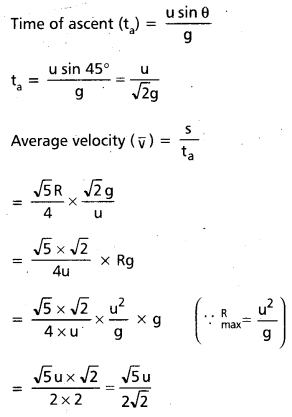
Question 8.
A particle is projected from the ground with some initial velocity making an angle of 45° with the horizontal. It reaches a height of 7.5 m above the ground while it travels a horizontal distance of 10m from the point of projection. Find the initial speed of projection, (g = 10m/s2)
Answer:
θ = 45°, g = 10 m/s2
Horizontal distance (x) = 10m.
Vertical distance (y) = 7.5 m.
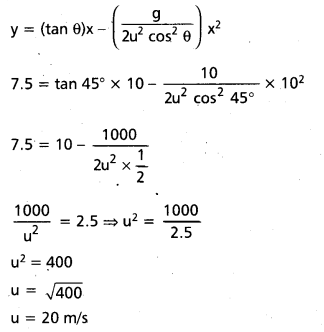
Additional Problems
Question 1.
State, for each of the following vector quantities, if it is a scalar are vector : volume, mass, speed, acceleration, density, number of mass, velocity, angular frequency. Displacement, angular velocity.
Answer:
Scalars, volume, mass, speed, density, number of moles, angular frequency vectors, acceleration, velocity, displacement, angular velocity.
![]()
Question 2.
Pick out the two scalar quantities in the following list angular momentum, work, current, linear momentum, electric field, average velocity, magnetic moment, relative velocity.
Answer:
Work and current are scalar quantities in the given list.
Question 3.
Pick out the only vector quantity in the following list : Temperature, pressure, impulse time, power, total path length, energy, gravitational potential, coefficient of friction, charge.
Answer:
Since, Impulse = change in momentum = force × time. A momentum and force are vector quantities hence impulse is a vector quantity.
Question 4.
State with reasons, whether the following algebraic operations with scalar and vector physical quantities are meaningful :
a) adding any two scalars,
b) adding a scalar to a vector of the same dimensions,
c) multiplying any vector by any scalar,
d) multiplying any two scalars,
e) adding any two vectors,
f) adding a component of a vector to the same vector.
Answer:
a) No, because only the scalars of same dimensions can be added.
b) No, because a scalar cannot be added to a vector.
c) Yes, when acceleration \(\vec{A}\) is multiplied by mass m, we get a force \(\vec{F}=m \vec{A}\), which is a meaningful operation.
d) Yes, when power P is multiplied by time t, we get work done = Pt, which is a useful operation.
e) No, because the two vectors of same dimensions can be added.
f) Yes, because both are vectors of same dimensions.
![]()
Question 5.
Read each statement below carefully and state with reasons, if it is true of false :
a) The magnitude of a vector is always a scalar,
b) each component of a vector is always a scalar,
c) the total path length is always equal to the magnitude of the displacement vector of a particle,
d) the average speed of a particle (defined as total path length divided by the time taken to cover the path) is either greater or equal to the magnitude of average velocity of the particle over the same interval of time,
e) Three vectors not lying in a plane can never add up to give a null vector.
Answer:
a) True, because magnitude is a pure number.
b) False, each component of a vector is also a vector.
c) True only if the particle moves along a straight line in the same direction, otherwise false.
d) True; because the total path length is either greater than or equal to the magnitude of the displacement vector.
e) True, as they cannot be represented by three sides of a triangle taken in the same order.
Question 6.
Establish the following vector inequalities geometrically or otherwise :
(a) |a + b| ≤ |a| + |b|
(b) |a + b| ≥ ||a| – |b||
(c) |a – b| ≤ |a| + |b|
(d) |a – b| ≥ ||a| – |b||
When does the equality sign above apply ?
Answer:
Consider two vectors \(\vec{A}\) and \(\vec{B}\) be represented by the sides \(\vec{OP}\) and \(\vec{OQ}\) of a parallelogram OPSQ. According to parallelogram law of vector addition; (\(\vec{A}+\vec{B}\)) will be represented by \(\vec{OS}\) as shown in figure. Thus OP = \(|\vec{A}|\), OQ = PS = \(|\vec{B}|\) and OS = \(|\vec{A}+\vec{B}|\)
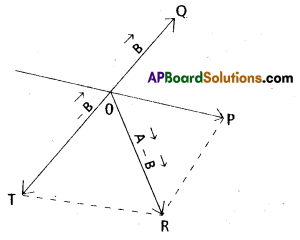
a) To prove |\(\vec{A}+\vec{B}\) | ≤ \(|\vec{A}|\) + \(|\vec{B}|\)
we know that the length of one side of a triangle is always less than the sum of the lengths of the other two sides. Hence from ∆OPS, we have OS < OP + PS or OS < OP + OQ or|\(\vec{A}+\vec{B}\)|< |\(\vec{A}+\vec{B}\)| ………………. (i) If the two vectors \(\vec{A}\) and \(\vec{B}\) are acting along a same straight line aind in same directions, then \(|\vec{A}+\vec{B}|=|\vec{A}|+|\vec{B}|\) …………….. (ii) combining the conditions mentioned in (i) and (ii) we get \(|\vec{A}+\vec{B}|=|\vec{A}|+|\vec{B}|\) b) To prove \(|\vec{A}+\vec{B}| \geq\|\vec{A}|+| \vec{B}\|\) From ∆OPS, we have OS + PS> OP or OS > |OP – PS| or OS > (OP – OQ) ………………. (iii)
(∵ PS = OQ)
The modulus of (OP – PS) has been taken because the LH.S is always positive but the R.H.S may be negative if OP < PS. Thus from (iii) we have \(|\vec{A}+\vec{B}|>\|\vec{A}|-| \vec{B}\|\) ………………. (iv)
If the two vectors \(\vec{A}\) and \(\vec{B}\) are acting along a straight line in opposite directions, then
\(|\vec{A}+\vec{B}|=\vec{A}-\vec{B}\) ……………. (v)
combining the conditions mentioned in (iv) and (v) we get
\(|\vec{A}+\vec{B}| \geq \vec{A}-\vec{B}\)
c)
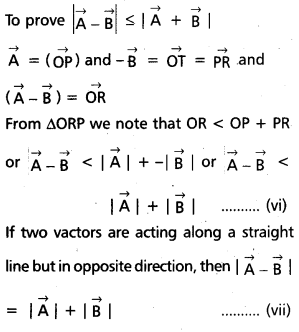
combining the conditions mentioned in (vi) and (vii) we get
\(|\vec{A}-\vec{B}| \leq|\vec{A}|+|\vec{B}|\)
d) To prove \(\overrightarrow{\mathrm{A}}-\overrightarrow{\mathrm{B}} \geq|| \overrightarrow{\mathrm{A}}|-| \overrightarrow{\mathrm{B}} \mid\)
From ∆OPR, we note that OR + PR > OP or OR > |OP – PR| or OR > |OP – OT| ………………. (viii)
(∵ OT = PR)
The modulus of (OP – OT) has been taken because L.H.S. is positive and R.H.S. may be negative of OP < OT From (viii), \(|\vec{A}-\vec{B}|>|| \vec{A}|-| \vec{B} \|\) …………….. (ix)
If the two vectors \(\vec{A}\) and \(\vec{B}\) are acting along the straight line in the same direction, then \(|\vec{A}-\vec{B}|\)
= \(|\vec{A}|-|\vec{B}|\) ………………. (x)
Combining the conditions mentioned in (ix) and (x) we get
\(\vec{A}-\vec{B} \geq \vec{A}-\vec{B}\)
![]()
Question 7.
Given a + b + c + d = 0. Which of the following statements are correct:
a) a, b, c and d must each be a null vector,
b) The magnitude of (a + c) equals the magnitude of (b + d),
c) The magnitude of a can never be greater than the sum of the magnitudes of b, c, and d,
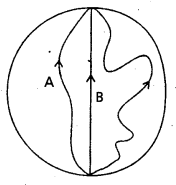
d) b + c must lie in the plane of a and d if a and d are not collinear, and in the line of a and d, if they are collinear ?
Answer:
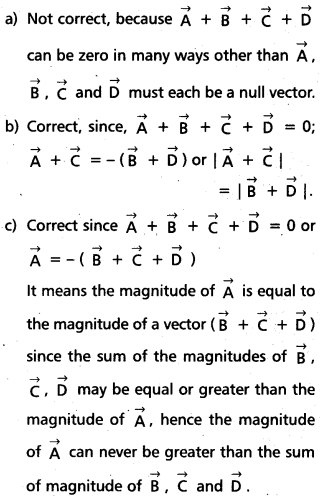
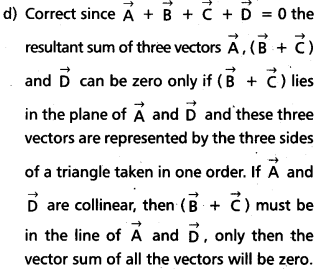
Question 8.
Three girls skating on a circular ice ground of radius 200 m start from a point P on the edge of the ground and reach a point Q diametrically opposite to P following different paths as shown in Fig. 4.20. What is the magnitude of the displacement vector for each ? For which girl is this equal to the actual length of path skate ?
Answer:
Displacement for each girl = \(\vec{PQ}\)
∴ Magnitude of the displacement of each girl = PQ
= diameter of circular ice ground
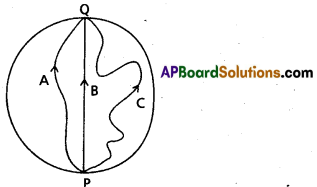
= 2 × 200 = 400 m
For girl B, the magnitude of displacement is equal to the actual length of path skated.
Question 9.
A cyclist starts from the centre O of a circular park of radius km, reaches the edge p of the pa’rk, then cycles along the circumference, and returns to the centre along QO as shown in Fig. 4.21. If the round trip takes 10 min, what is the
(a) net displacement,
(b) average velocity and
(c) average speed of the cyclist ?
Answer:
a) Here, net displacement = zero
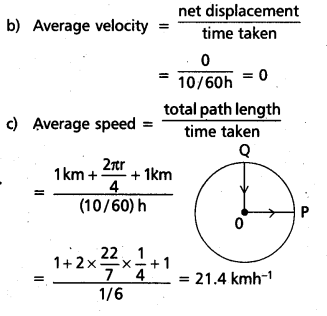
![]()
Question 10.
On an open ground, a motorist follows a track that turns to his left by an angle of 60° after every 500m. Starting from a given turn, specify the displacement of the motorist at the third, sixth and eighth turn. Compare the magnitude of the displacement with the total path length covered by the motorist in each case.
Answer:
In this problem, the path is regular hexagon ABCDEF of side length 500m let the motorist start from A.
Third turn : The motor cyclist will take the third turn at D. Displacement vector at D = \(\overrightarrow{A D}\) Magnitude of this displacement
= 500 + 500 = 1000 m
Total path length from A to D
= AB + BC + CD = 500 + 500 + 500 = 1500 m.
Sixth turn : The motor cyclist takes the sixth turn at A. So displacement vector is null vector – Total path length
= AB + BC + CD + DE + EF + FA = 6 × 500 = 3000 m.
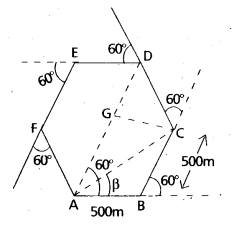
Eighth turn : The motor cyclist takes the eighth turn at C. The displacement vector = \(\overrightarrow{\mathrm{AC}}\), which is represented by the diagonal of the parallelogram ABCG.
So, |\(\overrightarrow{\mathrm{AC}}\)|
= \(\sqrt{(500)^2+(500)^2+2 \times 500 \times 500 \times \cos 60^{\circ}}\)
= \(\sqrt{(500)^2+(500)^2+250000}\)
= 866.03 m
tan β = \(\frac{500 \sin 60^{\circ}}{500+500 \sin 60^{\circ}}=\frac{500 \times \sqrt{3} / 2}{500(1+1 / 2)}\)
= \(\frac{1}{\sqrt{3}}\) = tan 30° or β = 30°
It means \(\overrightarrow{\mathrm{AC}}\) makes an angle 30° with the initial direction.
Total path length = 8 × 500 = 4000 m.
Question 11.
A passenger arriving in a new town wishes to go from the station to a hotel located 10 km away on a straight road from the station. A dishonest cabman takes him along a circuitous path 23 km long and reaches the hotel in 28 min. What is (a) the average speed of the taxi, (b) the magnitude of average velocity ? Are the two equal ?
Answer:
Here, actual path length travelled, S = 23 km, displacement = 10 km, time taken, t = 28min = 28/60h
a) Average speed of a taxi
= \(\frac{\text { actual path length }}{\text { time taken }}=\frac{23}{28 / 60}\)
= 49.3 km/hr
b) Magnitude of average velocity
= \(\frac{\text { displacement }}{\text { time taken }}=\frac{10}{(28 / 60)}\)
= 21.4 km/hr
The average speed is not equal to the magnitude of the average velocity. The two are equal for the motion of taxi along a straight path in one direction.
![]()
Question 12.
Rain is falling vertically with a speed of 30 ms-1. A woman rides a bicycle with a- speed of 10 m s-1 in the north to south direction. What is the direction in which she should hold her umbrella ?
Answer:
The rain is falling along OA with speed 30 ms-1 and woman rider is moving along OS with speed 10 ms-1 i.e OA = 30 ms-1 & OB = 10ms-1. The woman rider can protect herself from the rain if she holds her umbrella in the direction of relative velocity of rainfall of woman. To draw apply equal and opposite velocity of woman on the rain i.e impress the velocity 10 ms-1 due to North on which is represented by OC. Now the relative velocity of rain w.r.t woman will be represented by diagonal OD of parallelogram OADL. if ∠AOD = θ, then
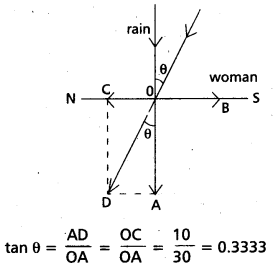
= tan 18°26′ or β = 18°26′ with vertical in forward direction.
Question 13.
A man can swim with a speed of 4.0 km/h in still water. How long does he take to cross a river 1.0 km wide if the river flows steadily at 3.0 km/h and he makes his strokes normal to the river current ? How far down the river does he go when he reaches the other bank ?
Answer:
Time to cross the river, t = \(\frac{\text { width of river }}{\text { speed of man }}\)
= \(\frac{1 \mathrm{~km}}{4 \mathrm{~km} / \mathrm{h}}=\frac{1}{4}\)h = 15min
Distance moved along the river in time
t = vr × t = 3 km/h × \(\frac{1}{4}\) h = 750 m.
Question 14.
The ceiling of a long hall is 25m high. What is the maximum horizontal distance that a ball thrown with a speed of 40 m s-1 can go without hitting the ceiling of the hall ?
Answer:
Here, u = 40 ms-1, H = 25 m; R = ?
Let θ be the angle of projection with the horizontal direction to have the maximum range, with maximum height 25m.
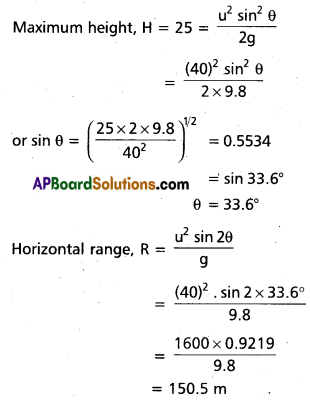
Question 15.
A cricketer can throw a ball to a maximum horizontal distance of 100m. How much high above the ground can the cricketer throw the same ball ?
Answer:
Let u be the velocity of projection of the ball. The ball will cover maximum horizontal distance when angle of projection with horizontal, θ = 45°. Then, Rmax = u2/g Here u2/g = 100m ………………………….. (i)
In order to study the motion of the ball along vertical direction, consider a point on the surface of earth as the origin and vertical upward direction as the positive direction of Y – axis. Taking motion of the ball along vertical upward direction we have.
uy = u, ay = -g, vy = 0, t = ? y0 = 0, y = ?
As uy = uy + ayt
∴ 0 = u + (-g)t or t = u/g
Also y = y0 + uyt + \(\frac{1}{2}\) a0t2
∴ y = 0 + u(u/g) + \(\frac{1}{2}\) (-g) u2 /g2
= \(\frac{\mathrm{u}^2}{\mathrm{~g}}-\frac{1}{2} \frac{\mathrm{u}^2}{\mathrm{~g}}\)
= \(\frac{1}{2} \frac{\mathrm{u}^2}{\mathrm{~g}}=\frac{100}{2}\)= 50m [from (i)]
![]()
Question 16.
A stone tied to the end of a string 80 cm long is whirled in a horizontal circle with a constant speed. If the stone makes 14 revolutions in 25s. What is the magnitude and direction of acceleration of the stone ?
Answer:
Here, r = 80 cm = 0.8 m ; v = 14/25s-1
∴ ω = 2πV
= 2 × \(\frac{22}{7} \times \frac{14}{25}=\frac{88}{25}\) rad s-1
The centripetal accerlation, a = ω2r
= \(\left(\frac{88}{25}\right)^2\) × 0.80
= 9.90 m/s2
The direction of centripetal acceleration is along the string directed towards the centre of circular path.
Question 17.
An aircraft executes a horizontal loop of radius 1.00 km with a steady speed of 900 km/h. Compare its centripetal acceleration with the acceleration due to gravity.
Answer:
Here, r = 1 km = 1000 m; v = 900 kmh-1
= 900 × (1000) m × (60 × 60 s)-1
= 250 ms-1
Centripetal acceleration, a = \(\frac{v^2}{r}\)
= \(\frac{(250)^2}{1000}\)
Now, a/g = \(\frac{(250)^2}{1000} \times \frac{1}{9.8}\) = 6.38.
Question 18.
Read each statement below carefully and state, with reasons, if it is true of false :
a) The net acceleration of a particle in circular motion is always along the radius of the circle towards the centre.
b) The velocity vector of a particle at a point is always along the tangent to the path of the particle at that point.
c) The acceleration vector of a particle in uniform circular motion averaged over one cycle is a null vector
Answer:
a) False, the net acceleration of a particle is towards the centre only in the case of a uniform circular motion.
b) True, because while leaving the circular path, the particle moves tangentially to the circular path.
c) True, the direction of acceleration vector in a uniform circular motion is directed towards the centre of circular path. It is constantly changing with time, the resultant of all these vectors will be a zero vector.
![]()
Question 19.
The position of a particle is given by r = 3.0 t \(\overline{\mathrm{i}}\) – 2.0t2 \(\overline{\mathrm{j}}\) + 4.0 \(\overline{\mathrm{k}}\) m where t is in seconds and the co-efficients have the proper units for r to be in metres, (a) Find the v and a of the particle ? (b) What is the magnitude and direction of velocity of the particle at t = 2.0 s ?
Answer:
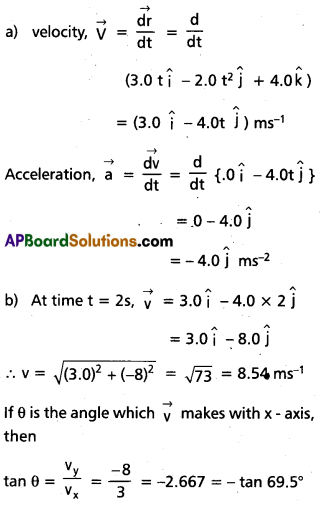
∴ θ = 69.5° below the x – axis
Question 20.
A particle starts from the origin at t = 0 s with a velocity of 10.0 \(\overline{\mathrm{j}}\) m/s and moves in the x – y plane with a constant acceleration of (8.0i + 2.0\(\overline{\mathrm{j}}\)) m s-2. (a) At what time is the x – coordinate of the particle 16 m? What is the y – coordinate of the particle at that time ? (b) What is the speed of the particle at the time ?
Answer:
Here, \(\vec{u}\) = 10.0 \(\overline{\mathrm{j}}\) ms-1 at t = 0
\(\vec{a}=\frac{\overrightarrow{d v}}{d t}=(8.0 \hat{i}+2.0 \hat{j}) \mathrm{ms}^{-2}\)
So \(d \vec{v}=(8.0 \hat{i}+2.0 \hat{j}) d t\)
Integrating it with in the limits of motion i.e. as time changes from 0 to t, velocity changes is from u to v, we have
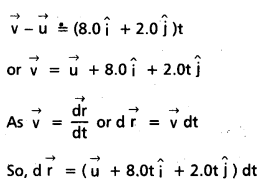
Integrating it within the conditions of motion i.e as time changes from 0 to t, displacement is from 0 to r, we have
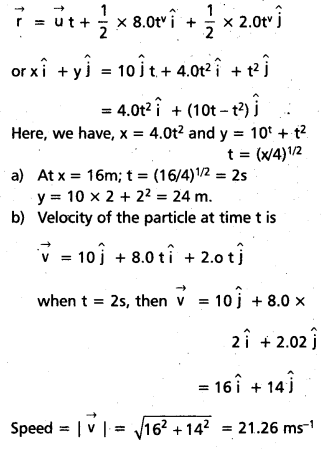
![]()
Question 21.
\(\overline{\mathrm{i}}\) and \(\overline{\mathrm{j}}\) are unit vectors along x – and y – axis respectively. What is the magnitude and direction of the vectors \(\overline{\mathrm{i}}\) + \(\overline{\mathrm{j}}\) and \(\overline{\mathrm{i}}\) – \(\overline{\mathrm{j}}\) ? What are the components of a vector A = 2 \(\overline{\mathrm{i}}\) + 3 \(\overline{\mathrm{j}}\) along the directions of \(\overline{\mathrm{i}}\) + \(\overline{\mathrm{j}}\) and \(\overline{\mathrm{i}}\) – \(\overline{\mathrm{j}}\)? [You may use graphical method]
Answer:
a) Magnitude of \((\hat{i}+\hat{j})=|\hat{i}+\hat{j}|\)
= \(\sqrt{(1)^2+(1)^2}=\sqrt{2}\)
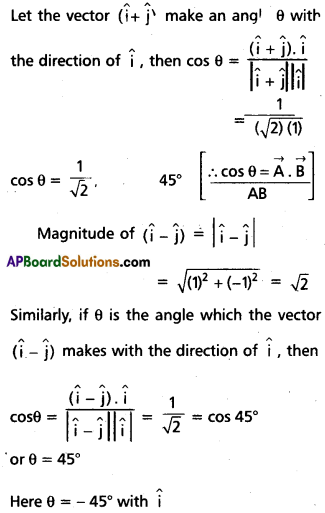
b) Here, \(\vec{B}=2 \hat{i}+3 \hat{j}\)
To find the component vectors of \(\overrightarrow{\mathrm{A}}\) along the vectors \((\hat{i}+\hat{j})\) we first find the unit vector along the vector \((\hat{i}+\hat{j})\). Let be the unit vector along the direction of vector \((\hat{i}+\hat{j})\).
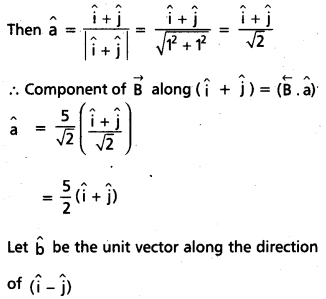
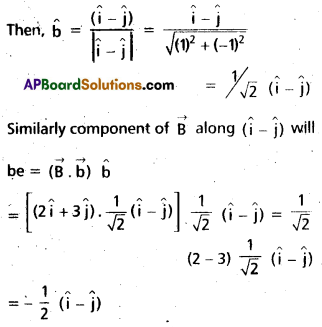
Question 22.
For any arbitrary motion in space, which of the following relations are true :
a) vaverage = (1/2) (v (t1) + v(t2))
b) vaverage = [r (t2) – r(t1)] / (t2 – t1)
c) v(t)average = v(0) + a t
d) r (t) = r (0) + v(0) t + (1/2) a t2
e) aaverage = [v (t2) – v(t1)] / (t2 – t1)
(The ‘average’ stands for average of the quantity over the time interval t1 to t2)
Answer:
The relations (b) and (e) are true; others are false because relations (a), (c) and (d) hold only for uniform acceleration.
![]()
Question 23.
Read each statement below carefully arid state, with reasons and examples, if it is true or fa1 e :
A scalar quantity is one that
a) is conserved in a process
b) can never take negative values
c) must be dimensionless
d) does not vary from one point to another in space
e) has the same value for observers with different orientations of axes.
Answer:
a) False, because energy is not conserved during inelastic collisions.
b) False, because the temperature can be negative.
c) False, because the density has dimensions.
d) False, because gravitational potential vary from point to point in space.
e) True, because the value of scalar does not change with orientation of axes.
Question 24.
An aircraft is flying at a height of 3400 m above the ground. If the angle subtended at a ground observation point by the aircraft positions 10.0 s apart is 30°, what is the speed of the aircraft ?
Answer:
In figure O is the observation point at the ground. A and B are the positions of aircraft for which ∠AOB = 30°. Draw a perpendicular OC on AB. Here OC = 3400m and ∠AOC = ∠COB = 15°
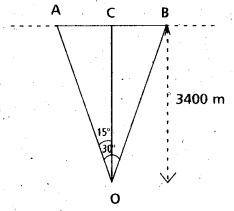
Time taken by aircraft from A to B is 10s
In ∆AOC, AC = OC tan 15° = 3400 × 0.2679
= 910.86m
AB = AC + CB = AC + AC = 2AC
= 2 × 910.86 m
Speed of the aircraft, v = \(\frac{\text { distance } A B}{\text { time }}\)
= \(\frac{2 \times 910.86}{10}\)
= 182.17 ms-1 = 182.2 ms-1
Question 25.
A vector has magnitude and direction. Does K have a location in space ? Can it vary with time? Will two equal vectors a and b at different locations in space necessarily have identical physical effects ? Give examples in support of your answer. .
Answer:
i) A vector in general has no difinite location in space because a vector remains uneffected whenever it is displaced anywhere in space provided its magnitude and direction do not change. However a position vector has a definite location in space.
ii) A vector can vary with time eg the velocity vector of an accelerated particle varies with time.
iii) Two equal vectors at different locations in space do not necessarily have some physical effects. For example two equal forces acting at two different points on a body with can cause the rotation of a body about an axis will not produce equal turning effect.
![]()
Question 26.
A vector has both magnitude and direction. Does it mean that any thing that has magnitude and direction is necessarily a vector ? The rotation of a body can be specified by the direction of the axis of rotation, and the angle of rotation about the axis. Does that make any rotation a vector ?
Answer:
No. There are certain physical quantities which have both magnitude and direction, but they are not vectors as they do not follow the laws of vectors addition, which is essential for vectors. The finite rotation of a body about an axis is not a vector because the finite rotations do not abey the laws of vectors addition. However, the small rotation of a body is a vector quantity as it obey the law of vector addition.
Question 27.
Can you associate vectors with (a) the length of a wire bent into a loop, (b) a plane area, (c) a sphere ? Explain.
Answer:
a) We cannot associate a vector with the length of a wire bent into a loop.
b) We can associate a vector with a plane area. Such a vector is called area vector and its direction is represented by outward drawn normal to the area.
c) we can not associate a vector with volume of sphere however a vector can be associated with the area of sphere.
Question 28.
A bullet fired at an angle of 30° with the horizontal hits the ground 3.0 km away. By adjusting its angle of projection, can one hope to hit a target 5.0 km away ? Assume the muzzle speed to be fixed, and neglect air resistance.
Answer:
Horizontal range R = \(\frac{\mathrm{u}^2 \sin 2 \theta}{\mathrm{g}}\)
3 = \(\frac{u^2 \sin 60^{\circ}}{g}=\frac{u^2}{g} \sqrt{3} / 2\) or \(\frac{\mathrm{u}^2}{\mathrm{~g}}=2 \sqrt{3}\)
Since the muzzle velocity is fixed, therefore, Max, horizontal range.
Rmax = \(\frac{u^2}{g}=2 \sqrt{3}\) = 3.464m.
So, the bullet cannot hit the target.
![]()
Question 29.
A fighter plane flying horizontally at an altitude of 1.5 km with speed 720 km/h passes directly overhead an anti-aircraft gun. At what angle from the vertical should the gun be fired for the shell with muzzle speed 600 m s-1 to hit the plane ? At what minimum altitude should the pilot fly the plane to avoid being hit ? (Take g = 10m s-2).
Answer:
In Fig. 0 be the position of gun and A be the position of plane. The speed of the plane,
v = \(\frac{720 \times 1000}{60 \times 60}\) = 200 ms-1
The speed of the shell, u = 600 m/s
Let the shell will hit the plane at B after time t if fired at an angle 0 with the vertical from O then the horizontal distance travelled by shel in time t is the same as the distance covered by plane.
i.e. ux × t = vt or u sin θ t = vt .
or sin θ = \(\frac{v}{u}=\frac{200}{600}\) = 0.3333 = sin 19.5°. or θ = 19.5°.
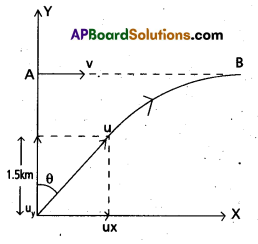
The plane will not be hit by the bullet from the gun if it is flying at a minimum height which is maximum height (H) attained by bullet after firing from gun.
Here H = \(\frac{u^2 \sin ^2(90-\theta)}{2 g}=\frac{u^2 \cos ^2 \theta}{g}\)
= \(\frac{(600)^2 \times(\cos 19.5)^2}{2 \times 10}\)
= 16000 m
= 16 km
Question 30.
A cyclist is riding with a speed of 27 . km/h. As he approaches a circular turn on the road of radius 80m, he applies brakes and reduces his speed at the constant rate of 0.50 m/s every second. What is the magnitude and direction of the net acceleration of the cyclist on the circular turn ?
Answer:
Here v = 27 km/h-1 = 27 × (1000 m) × (60 × 60s)-1 = 7.5 ms-1, r = 80m centripetal acceleration
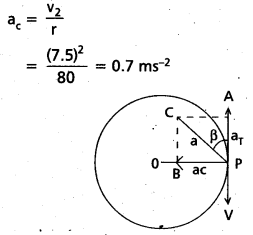
Let the cyclist applies the brakes at the point P of the Circular turn, then tangential acceleration aT will act opposite to velocity. Acceleration along the tangent, aT = 0.5 ms-2 Angle between both the acceleration is 90° Therefore, the magnitude of the resultant acceleration.
a = \(\sqrt{a c^2+a_T^2}\)
= \(\sqrt{(0.7)^2+(0.5)^2}\)
= 0.86 ms-2
Let the resultant acceleration make an angle β with the tangent i.e. the direction of velocity of the cyclist, then,
tan β = \(\frac{\mathrm{a}_{\mathrm{c}}}{\mathrm{a}_{\mathrm{T}}}=\frac{0.7}{0.5}\) = 1.4
or β = 54° 28′
![]()
Question 31.
a) Show that for a projectile the angle between the velocity and the x-axis as a function of time is given by
b) Shows that the projection angle θ for a projectile launched from the origin is given by θ(t) = tan-1 \(\left[\begin{array}{cc}
v_{\theta y} & -g t \\
v_{0 x}
\end{array}\right]\)
θ0 = tan-1 \(\left(\frac{4 h_m}{R}\right)\)
Where the symbols have their usual meaning
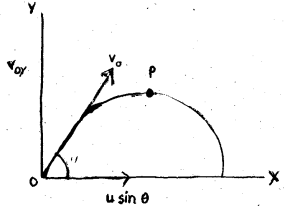
Answer:
a) Let vox and voy be the initial component velocity of the projectile at O along OX direction and OY direction respectveIy, where OX is horizantal and oy is vertical
Let the projectile go from o to p in time t and vx, vy be the component velocity of projectile at P along horizantal and vertical directions respectively. Then vy = voy – gt. and vx = vox
If θ is the angle which the resultant velocity \(\overrightarrow{\mathrm{v}}\) makes with horizontal direction, then
tan θ = \(\frac{v y}{v x}=\frac{v_{o y}-g t}{v_{o x}}\) or
θ = tan-1 \(\left[\frac{v_{\mathrm{oy}}-g t}{v_{o x}}\right]\)
b) In angular projection, maximum vertical height,
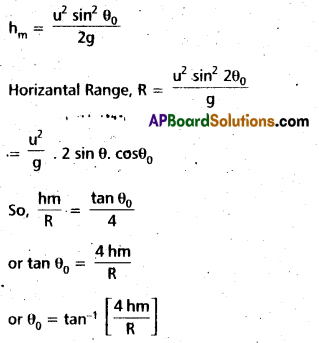
Textual Examples
Question 1.
Rain is falling vertically with a speed of 35 m s-1. Winds starts blowing after sometime with a speed of 12 m s-1 in east to west direction. In which direction should a boy waiting at bus stop hold his umbrella?
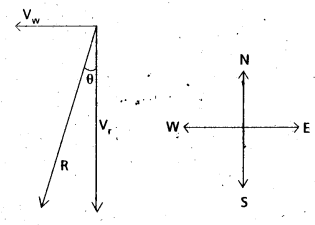
Answer:
The velocity of the rain and the wind are represented by the vectors vr and vw in Fig. a e in the direction specified by the problem. Using the rule of vector addition, we see that the resultant of vr and vw is R as shown in the figure. The magnitude of R is
R = \(\sqrt{v_{\mathrm{r}}^2+v_{\mathrm{w}}^2}=\sqrt{35^2+12^2}\) m s-1 = 37 m s-1
The direction θ that R makes with the vertical is given by
tan θ = \(\frac{v_w}{v_r}=\frac{12}{35}\) = 0343
Or, θ = tan-1 (0.343) = 19°
Therefore, the boy should hold his umbrella in the vertical plane at an a glass about 19° with vertical towards the east.
![]()
Question 2.
Fine, the magnitude and direction of the resultant of two vectors A and B in terms of their magnitudes and angle θ between them.
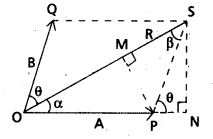
Answer:
Let OP and OQ represent the two vectors A and B making an angle θ (fig.). Then using the parallelogram method of vector addition, OS represents the vector R :
R = A + B
SN is normal to OP and PM is normal to OS.
From the geometry of the figure,
OS2 = ON2 + SN2
but ON = OP + PN = A + B cos θ
SN = B sin θ
OS2 = (A + B cos θ)2 + (B sin θ)2
or, R2 = A2 + B2 + 2AB cos θ
R = \(\sqrt{A^2+B^2+2 A B \cos \theta}\) …………….. (1)
In ∆ OSN, SN = OS sin α = R sin α, and in ∆ PSN, SN = PS sin θ = B sin θ
Therefore, R sin θ = B sin θ
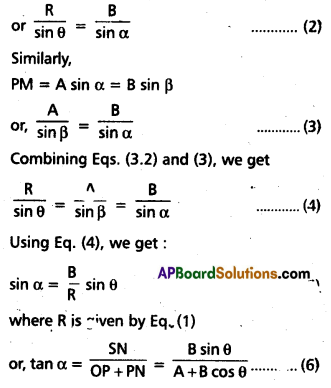
Equation (1) gives the magnitude of the resultant and Eqs. 5 & 6 its direction. Equation ((1) a) is known as the Law of ‘ cosines and Eq. (4) as the Law of sines.
Question 3.
A motorboat is racing towards north at 25 km/h and the water current in that region is 10 km/h in the direction of 60° east of south. Find the resultant velocity of the boat.
Answer:
The vector vb representing the velocity of the motorboat and the vector vc representing the water current are shown in Fig. in directions specified by the problem. Using the parallelogram method of addition, the resultant R is obtained in the direction shown in the figure.
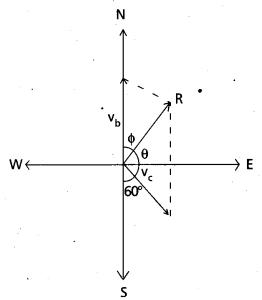
We can obtain the magnitude of R using the Law of cosine :
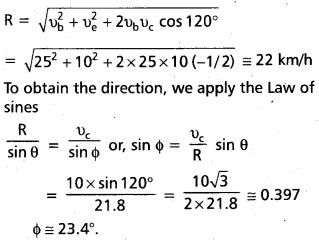
![]()
Question 4.
The position of a particle is given by r =\(3.0 t \overline{\mathrm{i}}+2.0 \overline{\mathrm{j}}^2 \mathrm{j}+5.0 \overline{\mathrm{K}}\) where t is in seconds and the coefficients have the proper units for r to he in metres. (a) Find v(t) and a(t) of the particle. (b) Find the magnitude and direction of v(t) at t = 1.0 s.
Answer:
v(t) = \(\frac{d r}{d t}=\frac{d}{d t}\left(3.0 t \hat{i}+2.0 t^2 \hat{j}+5.0 \hat{k}\right)\)
= \(3.0 \hat{\mathrm{i}}+4.0 t \hat{\mathrm{j}}\)
a(t) = \(\frac{d v}{d t}=+4.0 \hat{\mathrm{j}}\)
a = 4.0 ms-2 along y-direction
At t = 1.0 s, v = \(3.0 \hat{\mathrm{i}}+4.0 \hat{\mathrm{j}}\)
It’s magnitude is v = \(\sqrt{3^2+4^2}\) = 5.0 m s-1 and direction is
θ = tan-1\(\left(\frac{v_{\mathrm{y}}}{v_{\mathrm{x}}}\right)\) = tan-1 \(\left(\frac{4}{3}\right)\) ≅ 53° with x-axis.
Question 5.
A particle starts from origin at t = 0 with a velocity 5.0 \(\hat{\mathrm{i}}\) m/s and moves in x-y plane under action of a force which produces a constant acceleration of (3.0 \(\hat{\mathrm{i}}\) + 2.0\(\hat{\mathrm{j}}\)) m/s2.
(a) What is the y- coordinate of the particle at the instant its x-co-ordinate is 84 m ?
(b) What is the speed of the particle at this time?
Answer:
The position of the particle is given by
r(t) = v0t + \(\frac{1}{2}\) at2
= \(5.0 \hat{i} t+(1 / 2)(3.0 \hat{i}+2.0 \hat{j}) t^2\)
= \(\left(5.0 t+1.5 t^2\right) \hat{i}+1.0 t^2 \hat{j}\)
Therefore, x(t) = 5.0t + 1.5 t2
y(t) = + 1.0t2
Givn x(t) = 84m, t =?
5.0 t + 1.5 t2 = 84 ⇒ t = 6s
At t = 6 s, y = 1.0 (6)2 = 36.0 m
Now the velocity v = \(\frac{\mathrm{dr}}{\mathrm{dt}}\)
= (5.0 + 3.0t)\(\hat{\mathrm{i}}+2.0 \mathrm{t} \hat{\mathrm{j}}\)
At t = 6s, v = \(23.0 \hat{i}+12.0 \hat{j}\)
speed = |v| = \(\sqrt{23^2+12^2}\) ≅ 26 m s-1
![]()
Question 6.
Rain is falling vertically with a speed of 35 m s-1. A woman rides a bicycle with a speed of 12 m s-1 in east to west direction. What is the direction in which she should hold her umbrella?
Answer:
In Fig. vr represents the velocity of rain and vb, the velocity of the bicycle, the woman is riding. Both these velocities are with respect to the ground. Since the woman is riding a bicycle, the velocity of rain as experienced by
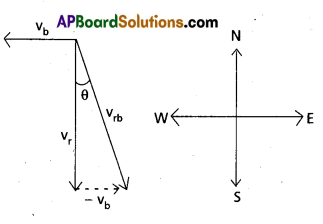
her is the velocity of rain relative to the velocity of the bicycle she is riding. That is
vrb = vr – vb
This relative velocity vector as shown in Fig. makes an angle θ with the vertical. It is given by
tan θ = \(\frac{v_{\mathrm{b}}}{v_{\mathrm{r}}}=\frac{12}{35}\) = 0.343 or, θ ≅ 19°
Therefore, the woman should hold her umbrella at an angle of about 19° with the vertical towards the west.
Note carefully the difference between this example and the Example 1. In Example 1, the boy experiences the resultant (vector sum) of two velocities while in this example, the woman experiences the velocity of rain relative to the bicycle (the vector difference of the two velocities).
Question 7.
Galileo, in his book Two new sciences, stated that “for elevations which exceed or fall short of 45° by equal amounts, the ranges are equal”. Prove this statement.
Answer:
For a projectile launched with velocity v0 at an angle θ0, the range is given by
R = \(\frac{v_0^2 \sin 2 \theta_0}{g}\)
Now, for angles, (45° + α) and (45° – α), 2θ0 is (90° + 2α) and (90° – 2α), respectively. The values of sin (90° + 2α) and sin (90° – 2α), are the same, equal to that of cos 2a. Therefore, ranges are equal for elevations which exceed or fall short of 45° by equal amounts α.
Question 8.
A hiker stands on the edge of a cliff 490 m above the ground and throws a stone horizontally with an initial speed of 15 ms-1. Neglecting air resistance, find the time taken by the stone to reach the ground and the speed with which it hits the ground. (Take g = 9.8m s-2).
Answer:
We choose the origin of the x , and y – axis at the edge of the cliff and t = 0 s at the instant the stone is thrown. Choose the positive direction of x-axis to be along the initial velocity and the positive direction of y-axis to be the vertically upward direction. The x, and y- components of the motion can be treated independently. The equations of motion are :
x (t) = x0 + υ0xt
y (t) = y0 + υ0y t + (1/2) ay t2
Here, x0 = y0 = 0, υ0y = 0, ay = – g = -9.8m s-2, υ0x = 15 m s-1.
The stone hits the ground when y(t) = – 490 m.
– 490 m = – (1/2) (9.8) t2.
This gives t = 10 s.
The velocity components are υx = υ0x and υy = υ0y – g t
so that when the stone hits the ground :
u0x = 15 m s-1
u0y = 0 – 9.8 × 10 = -98 m s-1
Therefore, the speed of the stone is
\(\sqrt{v_x^2+v_y^2}=\sqrt{15^2+98^2}\) = 99 m s-1.
![]()
Question 9.
A cricket ball is thrown at a speed of 28 m s-1 in a direction 30° above the horizontal. Calculate (a) the maximum height, (b) the time taken by the ball to return to the same level and (c) the distance from the thrower to the point where the ball returns to the same level.
Answer:
a) The maximum height is given by
hm = \(\frac{\left(v_0 \sin \theta_0\right)^2}{2 g}=\frac{\left(28 {in} 30^{\circ}\right)^2}{2(9.8)}\) m
= \(\frac{14 \times 14}{2 \times 9.8}\) = 10.0 m
(u0 sin0o)2 (28 in 30°)2 . hm ~ 2g “ 2(9.8) m
b) The time taken to return to the same level is
Tf = (2 υ0 sinθ0)/g = (2 × 28 × sin30°)/9.8
= 28 / 9.8 s = 2.9 s
c) The distance from the thrower to the point where the ball returns to the same level is
R = \(\frac{\left(v_0^2 \sin 2 \theta_0\right)}{g}=\frac{28 \times 28 \times \sin 60^{\circ}}{9.8}\)
= 69 m
Question 10.
An insect trapped in a circular groove of radius 12 cm moves along the groove steadily and completes 7 revolutions in 100 s, (a) What is the angular speed and the linear speed of the motion ? (b) Is the acceleration vector a constant vector ? What is its magnitude ?
Answer:
This is an example nf uniform circular motion. Here R = 12 cm. The angular speed ω is given by
ω = 2π/T = 2π × 7/100 = 0.44 rad/s ,
The linear speed υ is :
υ = ω R = 0.44 s-1 × 12 cm = 5.3 cm s-1
The direction of velocity v is along the tangent to the circle at every point. The acceleration is directed towards the centre of the circle. Since this direction changes continuously, acceleration here is not a constant vector. However, the magnitude of acceleration is constant :
a – ω2 R = (0.44 s-1)2 (12 cm)
= 2.3 cm s-2
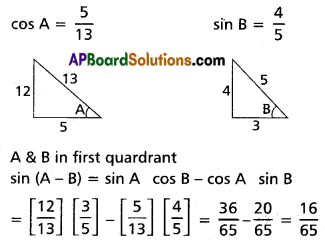
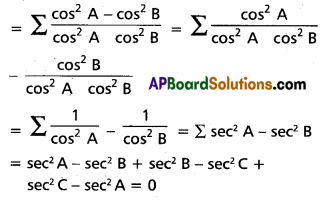
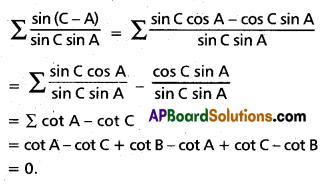
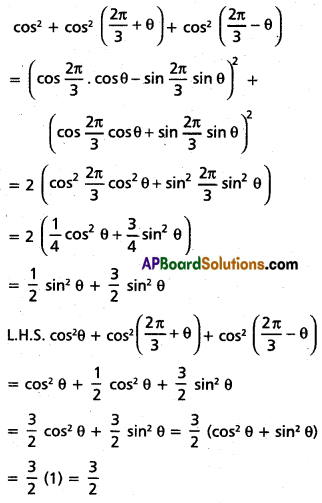
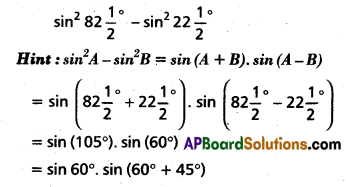
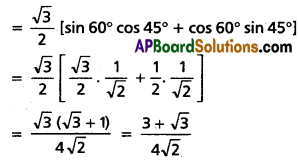
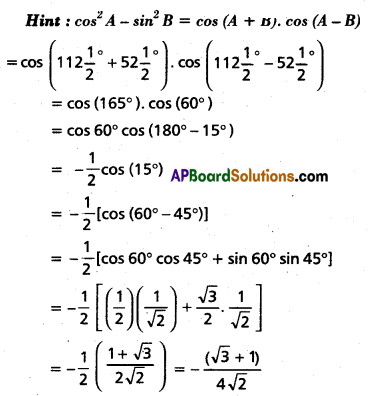
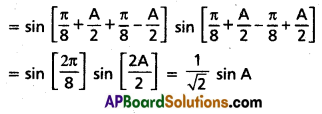
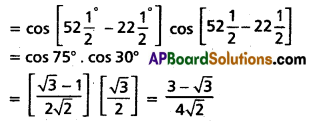
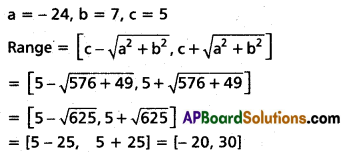
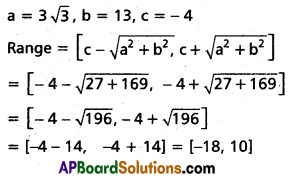
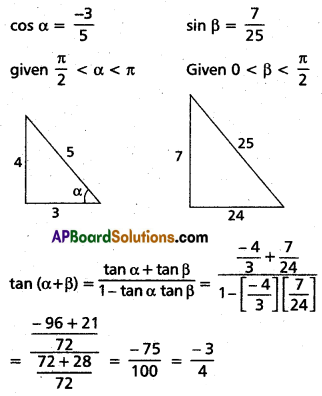
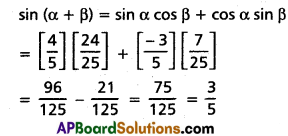
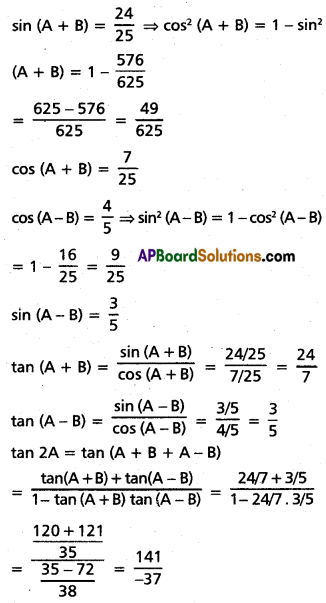
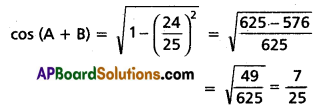
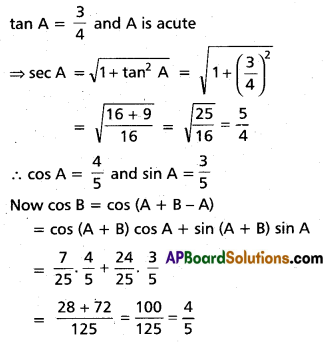
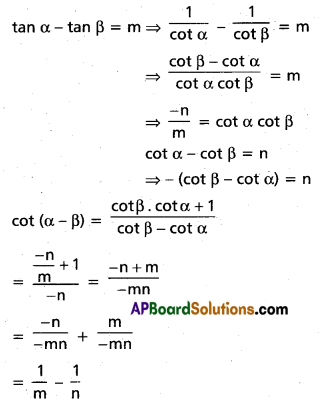
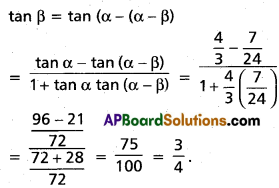
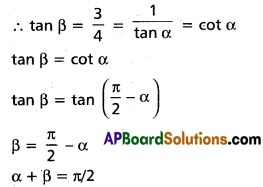
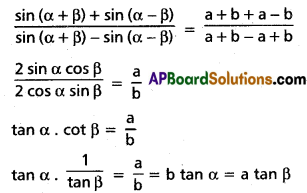
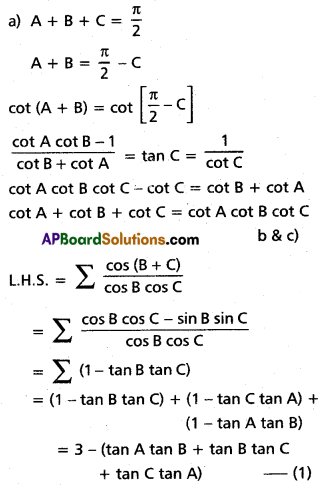
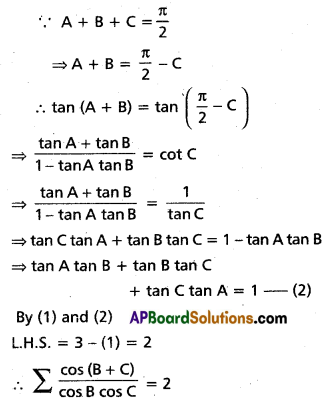






 The process in the picture is
The process in the picture is The equipment show in the figure is
The equipment show in the figure is

